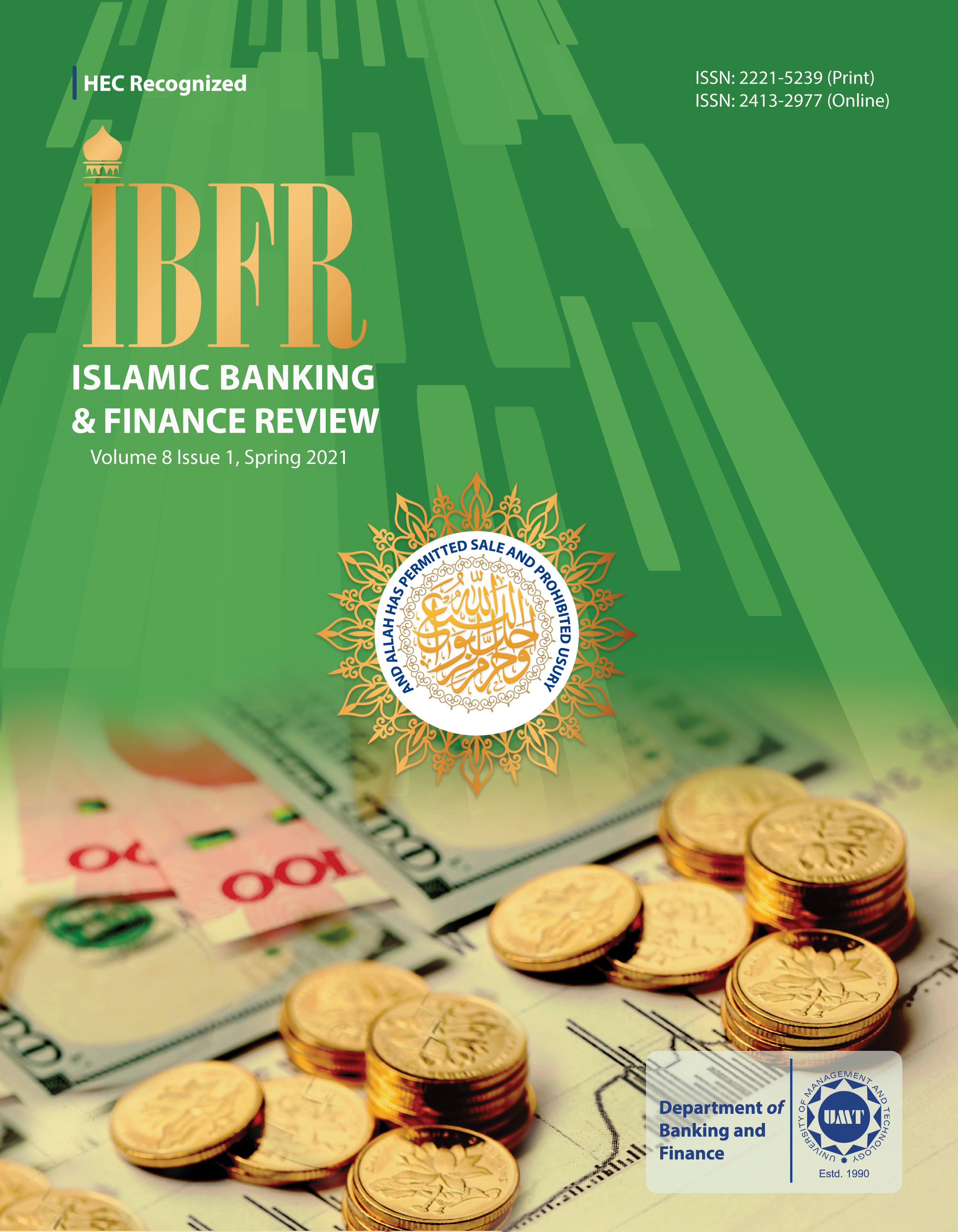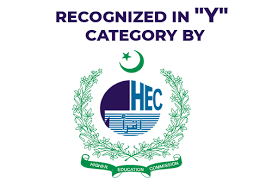Factors Affecting Profit Distribution Management of Islamic Banks: Moderating Role of Corporate Governance
Abstract
 Abstract Views: 315
Abstract Views: 315
This study aimed to ascertain the factors that affect the Profit Distribution Management (PDM) practices employed by Islamic banks (IBs) to retain their market share. It further analysed whether the presence of Islamic corporate governance can smoothen the profit sharing mechanism followed by the IBs. The study utilized the panel data analysis technique to analyse the data collected from 40 full-fledged IBs for the period 2010-2017 from three different regions, that is, South Asia, Middle East and South East Asia. The findings of the study support the premise that third party funds, asset composition, capital adequacy and market share all have a significant and positive impact on the PDM practices of IBs. Moreover, Islamic corporate governance strengthens the relationship between market share and the PDM practices of IBs. The results of this study have policy implications for the regulators of IBs and financial institutions as they provide insight into the factors that affect the PDM practices of IBs.
Downloads
References
AAOIFI (2004), Accounting, Auditing and Governance Standards for Islamic Financial Institutions. Accounting and Auditing Organization for Islamic Financial Institutions.
Abu-Tapanjeh, A. M. (2009). Corporate governance from the Islamic perspective: A comparative analysis with OECD principles. Critical Perspectives on Accounting, 20(5), 556-567. https://doi.org/10.1016/j.cpa.2007.12.004 DOI: https://doi.org/10.1016/j.cpa.2007.12.004
Aebi, V., Sabato, G., & Schmid, M. (2012). Risk management, corporate governance, and bank performance in the financial crisis. Journal of Banking & Finance, 36(12), 3213-3226. https://doi.org/10.1016/j.jbankfin.2011.10.020 DOI: https://doi.org/10.1016/j.jbankfin.2011.10.020
Alhammadi, S., Archer, S., Padgett, C., & Karim, R. A. A. (2018). Perspective of corporate governance and ethical issues with profit sharing investment accounts in Islamic banks. Journal of Financial Regulation and Compliance, 26(3), 406-424. https://doi.org/10.1108/JFRC-01-2017-0014 DOI: https://doi.org/10.1108/JFRC-01-2017-0014
Ali, S., Hassan, D., Butt, M., & Pervaiz, A. N. (2020). Impact of awareness on profit distribution management by Islamic banks in Pakistan: An Empirical Investigation. COMSATS Journal of Islamic Finance, 5(1), 1-21. https://doi.org/10.26652.cjif.5202015 DOI: https://doi.org/10.26652/cjif.5202015
Bader, B. S. (2009). The executive committee: Roles, uses, and abuses. Board Room Press.
BCBS. (2015). Corporate Governance Principles for Banks. Basel: Basel Committee on Banking Supervision.
Chariri, A. (2019). Corporate governance and financial performance in Islamic banks: the role of the sharia supervisory board in multiple-layer management. Banks and Bank Systems, 14(4), 183-191. DOI: https://doi.org/10.21511/bbs.14(4).2019.17
Chong, B. S., & Liu, M. H. (2009). Islamic banking: interest-free or interest-based? Pacific-Basin Finance Journal, 17(1), 125-144. https://doi.org/10.1016/j.pacfin.2007.12.003 DOI: https://doi.org/10.1016/j.pacfin.2007.12.003
da Silva, A. L. C., & Leal, R. P. C. (2005). Corporate governance index, firm valuation and performance in Brazil. Revista Brasileira de Finanças, 3(1), 1-18.
Farook, S., Hassan, M. K., & Clinch, G. (2012). Profit distribution management by Islamic banks: An empirical investigation. The Quarterly Review of Economics and Finance, 52(3), 333-347. https://doi.org/10.1016/j.qref.2012.04.007 DOI: https://doi.org/10.1016/j.qref.2012.04.007
Freeman, R. E., Wicks, A. C., & Parmar, B. (2004). Stakeholder theory and “the corporate objective revisited”. Organization Science, 15(3), 364-369. https://doi.org/10.1287/orsc.1040.0066 DOI: https://doi.org/10.1287/orsc.1040.0066
Haron, S., & Ahmad, N. (2000). The effects of conventional interest rates and rate of profit on funds deposited with Islamic banking system in Malaysia. International Journal of Islamic Financial Services, 1(4), 1-7.
HKSA. (2001). Corporate Governance Disclosure in Annual Reports: A Guide to Current Requirements and Recommendations for Enhancement. Hong Kong: Hong Kong Society of Accountants.
Hosen, M. N., & Muhari, S. (2013). Efficiency of the sharia rural bank in Indonesia lead to modified camel. International Journal of Academic Research in Economics and Management Sciences, 2(5), 34-53. DOI: https://doi.org/10.6007/IJAREMS/v2-i5/298
IFC, & Huakamah. (2008). A Corporate Governance Survey of Listed Companies and Banks across the Middle East & North Africa. International Finance Corporation (IFC) and Huakamah-The Institute for Corporate Governance.
IFC. (2014). Corporate Governance Scorecards: Assessing and Promoting the Implementation of Codes of Corporate Governance. International Finance Corporation.
IFSB. (2006). Guiding Principles on Corporate Governance for Institutions Offering Only Islamic Financial Services Excluding Islamic Insurance (Takâful) Institutions and Islamic Mutual Funds. Kuala Lumpur: Islamic Financial Services Board.
IFSB. (2009). Guiding Principles on Shariah Governance Systems for Institutions Offering Islamic Financial Services. Islamic Financial Services Board.
IFSB. (2013). Strategic Performance Plan 2012–2015. Islamic Financial Services Board.
Ismal, R. (2011). Understanding characteristics of depositors to develop the Indonesian Islamic banks. Journal of Islamic Economics, Banking and Finance, 113(465), 1-18.
James-Overheu, C., & Cotter, J. (2009). Corporate governance, sustainability and the assessment of default risk. Asian Journal of Finance and Accounting, 1(1), 34-53. DOI: https://doi.org/10.5296/ajfa.v1i1.93
Karim, R. A. A., & Archer, S. (2013). Islamic finance: the new regulatory challenge. John Wiley & Sons.
Kartika, S. B., & Adityawarman, A. (2014). Analisis Faktor-Faktor yang Mempengaruhi Profit Distribution Management: Studi Empiris Bank Umum Syariah di Indonesia Periode 2009-2012 [Doctoral Dissertation]. Fakultas Ekonomika dan Bisnis.
Kasri, R., & Kassim, S. H. (2009). Empirical determinants of saving in the Islamic banks: Evidence from Indonesia. Journal of King Abdulaziz University: Islamic Economics, 22(2), 1-10. DOI: https://doi.org/10.4197/islec.22-2.7
Khan, M. M., Bhatti, M. I., Rosly, S. A., & Zaini, M. A. M. (2008). Risk‐return analysis of Islamic banks' investment deposits and shareholders' fund. Managerial finance, 34(10), 695-707. https://doi.org/10.1108/03074350810891010 DOI: https://doi.org/10.1108/03074350810891010
Love, I., & Klapper, L. F. (2002). Corporate governance, investor protection, and performance in emerging markets. The World Bank. DOI: https://doi.org/10.1596/1813-9450-2818
Mollah, S., & Zaman, M. (2015). Shari’ah supervision, corporate governance and performance: Conventional vs. Islamic banks. Journal of Banking & Finance, 58, 418-435. DOI: https://doi.org/10.1016/j.jbankfin.2015.04.030
Mulyo, G. P., & Mutmainah, S. (2013). Determinan profit distribution management bank syariah di Indonesia periode 2008-2011. Imanensi: Jurnal Ekonomi, Manajemen, Dan Akuntansi Islam, 1(1), 31-41. DOI: https://doi.org/10.34202/imanensi.1.1.2013.31-41
Nur Afni, Y., Yunina, Y., Sri, M., & Dy Ilham, S. (2019). Factors Affecting Profit Distribution Management of General Islamic Banks in Indonesia. Factors Affecting Profit Distribution Management of General Islamic Banks in Indonesia, 1, 1-14.
OECD (2015). G20/OECD Principles of Corporate Governance. Organisation for Economic Cooperation Development Publishing. DOI: https://doi.org/10.1002/bl.30032
Philip, G. (1997). Islamic banking: a study in Singapore. The International Journal of Bank Marketing, 15(6), 204-216. DOI: https://doi.org/10.1108/02652329710184433
Rachmawati, E., & Syamsulhakim, E. (2004). Factors affecting mudaraba deposits in Indonesia. Department of Economics Padjadjaran University.
Rettab, B., Kashani, H., Obay, L., & Rao, A. (2010). Impact of market power and efficiency on performance of banks in the Gulf Cooperation Council countries. International Research Journal of Finance and Economics, 50(50), 190-203.
Risfandy, T. (2019). Profit Distribution Management and Islamic Banks’ Market Power in Indonesia. Sebelas Maret Business Review, 4(2), 58-67. https://doi.org/10.20961/smbr.v4i2.36103 DOI: https://doi.org/10.20961/smbr.v4i2.36103
Rosman, R., Abd Wahab, N., & Zainol, Z. (2014). Efficiency of Islamic banks during the financial crisis: An analysis of Middle Eastern and Asian countries. Pacific-Basin Finance Journal, 28, 76-90. https://doi.org/10.1016/j.pacfin.2013.11.001 DOI: https://doi.org/10.1016/j.pacfin.2013.11.001
Semonson, E, & Youm, D. (2008). Muslim economic thinking: A survey of contemporary literature. International Centre for Research in Islamic Economics, King Abdul Aziz University.
Sundararajan, V. (2008). Issues in managing profit equalization reserves and investment risk reserves in Islamic banks. Journal of Islamic Economics, Banking and Finance, 4(1), 1-11.
UNEP, F. (2011). Guide to Banking & Sustainability. Geneva: Instaprint, october, 40, 1-40.
Wafaretta, V., & Rahman, A. F. (2016). The impact of banks’ characteristics on profit distribution management of Islamic banks. Procedia-Social and Behavioral Sciences, 219, 769-776. https://doi.org/10.1016/j.sbspro.2016.05.066 DOI: https://doi.org/10.1016/j.sbspro.2016.05.066
Yusoff, R., & Wilson, R. (2005). An econometric analysis of conventional and Islamic bank deposits in Malaysia. Review of Islamic Economics, 9(1), 1-31.
Zheng, C., Moudud-Ul-Huq, S., Rahman, M. M., & Ashraf, B. N. (2017). Does the ownership structure matter for banks’ capital regulation and risk-taking behavior? Empirical evidence from a developing country. Research in International Business and Finance, 42, 404-421. https://doi.org/10.1016/j.ribaf.2017.07.035 DOI: https://doi.org/10.1016/j.ribaf.2017.07.035
Copyright (c) 2021 Kiran Shahzadi1, Huma Ayub, Malik Shahzad Shabbir, Attiya Yasmin

This work is licensed under a Creative Commons Attribution 4.0 International License.
Authors retain copyright and grant the journal right of first publication with the work simultaneously licensed under a Creative Commons Attribution (CC-BY) 4.0 License that allows others to share the work with an acknowledgement of the work’s authorship and initial publication in this journal.












